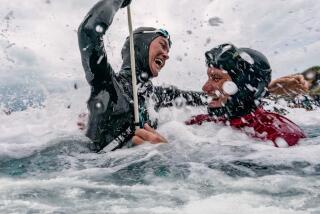Panic Poses Risk to Divers, Study Shows
- Share via
WASHINGTON — Panic poses a potentially life-threatening risk to more than half of scuba divers, a researcher believes.
Panic may be a hidden cause in many diving deaths for which no specific cause can be found and may be a factor in other cases, such as entanglement in nets, said William Morgan, director of the University of Wisconsin-Madison Sport Psychology Laboratory. Many recreational divers don’t realize this and probably should pick a safer activity, he said.
Morgan’s review of research, including his own studies, was published in the journal Sports Medicine. An expert with a diving organization says the article may overstate the amount of risk, however.
Morgan and his colleagues surveyed 173 men who had been diving for an average of seven years and 72 women whose diving experience averaged five years. The respondents, who filled out questionnaires, had answered ads in a diving publication.
Sixty-four percent of women and 50% of men reported at least one incident of panic while diving, the report said. Forty-eight percent of men and 35% of women considered the incidents life-threatening. Morgan defined panic as irrational behavior, usually in the presence of a perceived danger, such as loss of visibility due to silt.
The male-female differences do not necessarily mean that women are more likely to panic, nor that men men are more likely to get into risky areas, Morgan said. Men may simply be more likely to deny they had panicked, or more likely to exaggerate the seriousness of the problem when they tell their story later, he said.
In general, psychological profiles indicate that divers feel above average in physical vigor and below average in tendencies to be tense or confused, Morgan said. And people who are less likely to be tense or confused should be less likely to panic, he said.
But, Morgan said, it takes only one incident to get into serious trouble in the water. For instance, a diver can become entangled in a bed of seaweed or a fishing net and forget that he or she could cut a way out with a knife carried in a leg sheath, he said.
And some people may be more prone than others to panic, Morgan said. People with test scores that indicate a tendency to panic should probably be encouraged to try other activities.
“It is common to panic under water,” said one diving instructor, Susan Schmidt, owner of “The” Dive Shop in Fairfax County, Va. “Everyone can go through a sudden state of, ‘Oh, my gosh, I have this problem.’ ”
But divers can think themselves through their problems, Schmidt said. “Diving is a thinking sport, so people who are used to rational thinking do exceptionally well in diving.”
The worst thing to do is to head rapidly to the surface without exhaling, causing too much pressure to build up in the lungs, among other problems, Schmidt said.
PADI International, the professional association of diving instructors, says problems can be prevented by relaxing during the dive and not exceeding a diver’s limitations. The trade group in Santa Ana also says panicked divers can be recognized by quick, jerky movements, wide and unseeing eyes and a lack of attention to the diver’s buddy.
One PADI official believes the danger is not as bad as Morgan’s study indicates. “If panic is as prevalent as the study finds, the question has to be asked, what effect it ultimately has,” said Al Hornsby, a vice president of the divers’ group.
There are many divers and relatively few deaths, Hornsby said. “I would surmise there are a lot of panic incidents without any particular consequences.”
About four U.S. divers of every 100,000 die each year, Morgan estimated. But he conceded that the estimate could be off because there are no reliable estimates of the number of U.S. divers. Morgan based his estimate on 2.5 million divers, but Hornsby says there could be 3 million, which would make the death rate lower.





